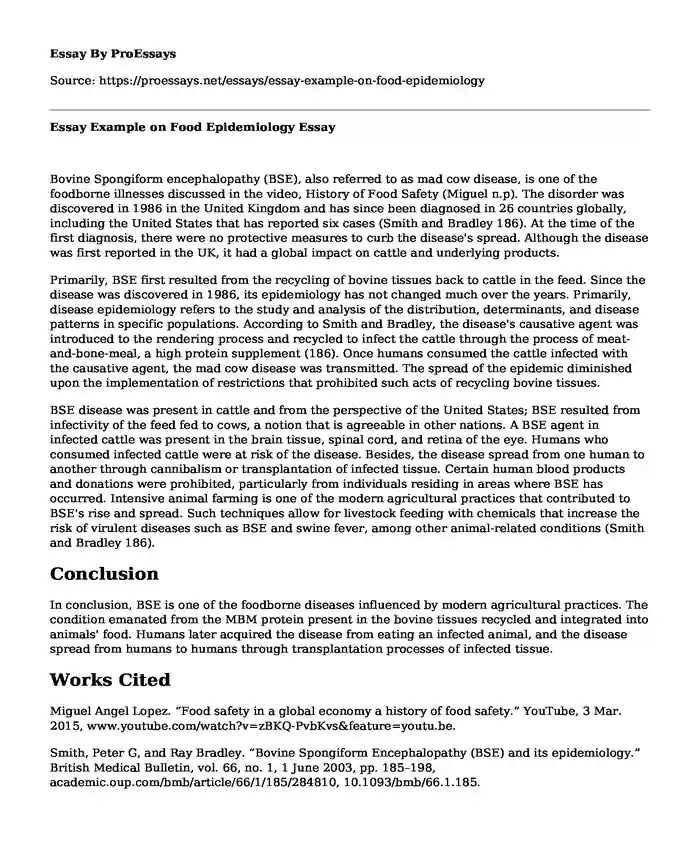Bovine Spongiform encephalopathy (BSE), also referred to as mad cow disease, is one of the foodborne illnesses discussed in the video, History of Food Safety (Miguel n.p). The disorder was discovered in 1986 in the United Kingdom and has since been diagnosed in 26 countries globally, including the United States that has reported six cases (Smith and Bradley 186). At the time of the first diagnosis, there were no protective measures to curb the disease's spread. Although the disease was first reported in the UK, it had a global impact on cattle and underlying products.
Primarily, BSE first resulted from the recycling of bovine tissues back to cattle in the feed. Since the disease was discovered in 1986, its epidemiology has not changed much over the years. Primarily, disease epidemiology refers to the study and analysis of the distribution, determinants, and disease patterns in specific populations. According to Smith and Bradley, the disease's causative agent was introduced to the rendering process and recycled to infect the cattle through the process of meat-and-bone-meal, a high protein supplement (186). Once humans consumed the cattle infected with the causative agent, the mad cow disease was transmitted. The spread of the epidemic diminished upon the implementation of restrictions that prohibited such acts of recycling bovine tissues.
BSE disease was present in cattle and from the perspective of the United States; BSE resulted from infectivity of the feed fed to cows, a notion that is agreeable in other nations. A BSE agent in infected cattle was present in the brain tissue, spinal cord, and retina of the eye. Humans who consumed infected cattle were at risk of the disease. Besides, the disease spread from one human to another through cannibalism or transplantation of infected tissue. Certain human blood products and donations were prohibited, particularly from individuals residing in areas where BSE has occurred. Intensive animal farming is one of the modern agricultural practices that contributed to BSE's rise and spread. Such techniques allow for livestock feeding with chemicals that increase the risk of virulent diseases such as BSE and swine fever, among other animal-related conditions (Smith and Bradley 186).
Conclusion
In conclusion, BSE is one of the foodborne diseases influenced by modern agricultural practices. The condition emanated from the MBM protein present in the bovine tissues recycled and integrated into animals' food. Humans later acquired the disease from eating an infected animal, and the disease spread from humans to humans through transplantation processes of infected tissue.
Works Cited
Miguel Angel Lopez. “Food safety in a global economy a history of food safety.” YouTube, 3 Mar. 2015, www.youtube.com/watch?v=zBKQ-PvbKvs&feature=youtu.be.
Smith, Peter G, and Ray Bradley. “Bovine Spongiform Encephalopathy (BSE) and its epidemiology.” British Medical Bulletin, vol. 66, no. 1, 1 June 2003, pp. 185–198, academic.oup.com/bmb/article/66/1/185/284810, 10.1093/bmb/66.1.185.
Cite this page
Essay Example on Food Epidemiology. (2024, Jan 10). Retrieved from https://proessays.net/essays/essay-example-on-food-epidemiology
If you are the original author of this essay and no longer wish to have it published on the ProEssays website, please click below to request its removal:
- Nursing Of the Future Safety - Research Paper
- Obesity Management Essay
- The Opioid Crisis and Mitigating It Through Youth Education
- Leadership in Nursing Presentation Paper Example
- Essay Sample on Nursing: An Underrated Yet Fulfilling Profession
- Essay Sample on Congenital Heart Defects: Atrioventricular Canal
- Paper Example on Nurse Julia Brown: Helping the Needy in Africa







